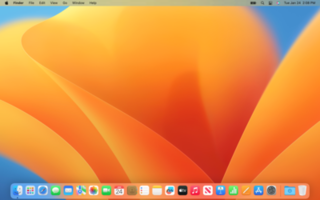
macOS is a Unix operating system developed and marketed by Apple Inc. since 2001. It is the primary operating system for Apple's Mac computers. Within the market of desktop and laptop computers, it is the second most widely used desktop OS, after Microsoft Windows and ahead of ChromeOS.

Microsoft PowerPoint is a presentation program, created by Robert Gaskins and Dennis Austin at a software company named Forethought, Inc. It was released on April 20, 1987, initially for Macintosh computers only. Microsoft acquired PowerPoint for about $14 million three months after it appeared. This was Microsoft's first significant acquisition, and Microsoft set up a new business unit for PowerPoint in Silicon Valley where Forethought had been located.

Adobe PageMaker is a discontinued desktop publishing computer program introduced in 1985 by the Aldus Corporation on the Apple Macintosh. The combination of the Macintosh's graphical user interface, PageMaker publishing software, and the Apple LaserWriter laser printer marked the beginning of the desktop publishing revolution. Ported to PCs running Windows 1.0 in 1987, PageMaker helped to popularize both the Macintosh platform and the Windows environment.

Macworld is a digital magazine and website dedicated to products and software of Apple Inc., published by Foundry, a subsidiary of IDG.
Macworld/iWorld was an information technology trade show with conference tracks dedicated to Apple's Mac platform. It was held annually in the United States during January. Originally Macworld Expo and then Macworld Conference & Exposition, the gathering dates back to 1985. The conference was organized by International Data Group (IDG), co-publisher of Macworld magazine.

MacLife was an American monthly magazine published by Future US. It focused on the Macintosh personal computer and related products, including the iPad and iPhone. It was sold as a print product on newsstands, and an interactive and animated app edition through the App Store. Between September 1996 and February 2007, the magazine was known as MacAddict.

System 6 is a graphical user interface-based operating system for Macintosh computers, made by Apple Computer It was released in 1988, and is part of the classic Mac OS series. It is a monolithic operating system, with cooperative multitasking based on an improved MultiFinder. The boxed version cost US$49, and it was included with all new Macintosh computers until 1991, when it was succeeded by System 7.

Macintosh Programmer's Workshop (MPW) is a software development environment for the Classic Mac OS operating system, written by Apple Computer. For Macintosh developers, it was one of the primary tools for building applications for System 7.x and Mac OS 8.x and 9.x. Initially MPW was available for purchase as part of Apple's professional developers program, but Apple made it a free download after it was superseded by CodeWarrior. On Mac OS X it was replaced by the Project Builder IDE, which eventually became Xcode.

Connectix Corporation was a software and hardware company, noted for having released innovative products that were either made obsolete as Apple Computer incorporated the ideas into system software, or were sold to other companies once they became popular. It was formed in October 1988 by Jon Garber; dominant board members and co-founders were Garber, Bonnie Fought, and close friend Roy McDonald. McDonald was still Chief Executive Officer and president when Connectix finally closed in August 2003.

Rhapsody is the development series of Apple Computer's next-generation operating system. Targeting only developers for a transition period, its releases came between Apple's purchase of NeXT in late 1996 and the announcement of Mac OS X in 1998. Rhapsody represented a new and exploratory strategy for Apple, more than an operating system, and runs on x86-based PCs and on Power Macintosh. Its OPENSTEP based Yellow Box API frameworks were ported to Windows NT for creating cross-platform applications. Eventually, the non-Apple platforms were discontinued, and later versions consist primarily of the OPENSTEP operating system ported to Power Macintosh, merging the Copland-originated GUI of Mac OS 8 with that of OPENSTEP. Several existing classic Mac OS frameworks were ported, including QuickTime and AppleSearch. Rhapsody can run Mac OS 8 and its applications in a paravirtualization layer called Blue Box for backward compatibility during migration to Mac OS X.
The Apple community is a group of people interested in Apple Inc. and its products, who report information in various media. Generally this has evolved into a proliferation of websites, but latterly has also expanded into podcasts, either speculating on rumors about future product releases, simply report Apple-related news stories, or have discussions about Apple's products and how to use them.
Canvas X is a drawing, imaging, and publishing computer program from Canvas GFX for personal computers.

Jason Snell is an American writer, editor, and podcaster whose professional career has been split between covering technology—heavily focused on Apple Inc.'s Macintosh computers, iPhones, and services—and pop culture. Snell was an early Internet publisher, producing the fiction journal InterText, as well as creating or editing several other early Internet magazines and websites. He served in a variety of editorial positions at IDG during more than 25 years, including as editor-in-chief of Macworld magazine. He finished up his IDG tenure serving as the senior vice president of IDG Consumer & Small Business Publishing (CSMB). He continues to write a weekly column at Macworld.
Red Ryder is a communications and terminal emulation software program released for the Apple Macintosh in 1984. Initially distributed as a shareware, the application offered rich features and configuration settings. Red Ryder was discontinued in 1989 and replaced by White Knight.

The Macintosh Quadra 660AV, originally sold as the Macintosh Centris 660AV, is a personal computer designed, manufactured and sold by Apple Computer from July 1993 to September 1994. It was introduced alongside the Quadra 840AV; the "AV" after both model numbers signifies video input and output capabilities and enhanced audio.
Meeting Maker is a cross-platform personal calendar and group scheduling software application from PeopleCube. First released in 1991 for Macintosh by ON Technology, support for other platforms followed in 1993 with Meeting Maker XP. Alongside Windows and Mac, native clients were released for OS/2 and Solaris, and later also for other platforms. Some support was also introduced for mobile platforms like Apple Newton, PalmPilot and Windows CE. Although powerful, its user interface - aiming at uniformity across multiple platforms — was criticized as weak and not supporting all features of target platforms.
Paracomp was a Macintosh programming company known for their 3D software, Swivel 3D and ModelShop and FilmMaker. FilmMaker was known for its packaging which was a 16mm film reel tin which was used to contain the software and manuals. Paracomp was also the publisher of the computer algebra system Milo, which was the first program on Macintosh able to perform symbolic computation using standard math notation. Paracomp was acquired by MacroMind in 1991 to briefly form MacroMind-Paracomp, before adding Authorware in 1992 and becoming Macromedia.

MacUser was a monthly computer magazine published by Ziff Davis in the United States, while the UK edition was published by Dennis Publishing.

Mac OS is the series of operating systems developed for the Macintosh family of personal computers by Apple Computer from 1984 to 2001, starting with System 1 and ending with Mac OS 9. The Macintosh operating system is credited with having popularized the graphical user interface concept. It was included with every Macintosh that was sold during the era in which it was developed, and many updates to the system software were done in conjunction with the introduction of new Macintosh systems.

The MacEnhancer is an expansion box originally developed in 1985 by Microsoft for Apple Computer's original Macintosh. Plugged into either the Macintosh's serial printer or modem ports, the MacEnhancer provides IBM-standard printer and serial ports as well as a passthrough for the Mac-standard serial port, for a net gain of three peripheral ports. Along with a provided disk of drivers, this expansion box allows the Macintosh to run a host of printers and other business peripherals not originally supported by Apple.














